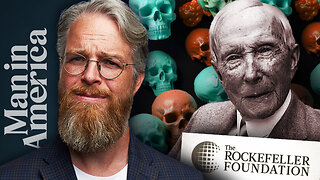Premium Only Content

Episode 2603: Audiobook Series: "Mary, Mother of All" Part 3 of 4: Chapters 7-11
Chapter 7
Divine Motherhood
"But when the fulness of the time was come, God sent his Son, made of a woman, made under the law." Galatians 4:4
Mary as Mother of Christ and the Church
Exploring the Theological and Christological Foundations of Mary's Role as the Mother of God
Introduction
The divine motherhood of Mary is a central tenet of Catholic faith, enshrined in the dogma that affirms her as the Mother of God (Theotokos). This teaching not only honors Mary but also solidifies key Christological doctrines about the nature of Christ as both fully God and fully man. In this chapter, we will explore how the Church, through the teachings of saints, theologians, and councils, has deepened its understanding of Mary’s divine motherhood. We will look at the simple aspects of Mary’s role for beginners, followed by a more in-depth examination for those wishing to understand the theological significance this title carries in the broader context of Christology.
Mary, Mother of Christ: Understanding the Basics
For beginners, it is essential to start with the fundamental role Mary plays in the life of Christ and, by extension, in the life of the Church. The title "Mother of God" was solemnly defined at the Council of Ephesus in 431 AD, but the understanding of Mary’s divine motherhood can be traced back to the very heart of Scripture.
Luke 1:31 shows the angel Gabriel announcing to Mary:
"Behold, thou shalt conceive in thy womb, and shalt bring forth a son; and thou shalt call his name Jesus."
Here, we see that Mary was chosen to bear the Word made flesh, the second Person of the Trinity. In her motherhood, Mary is not merely the biological mother of Jesus, but rather, she participates in God’s salvific plan in a profound and unique way.
For beginners, this is the key takeaway: Mary is the Mother of God because the child she bore was fully God, even from the moment of conception. This foundational truth is an essential part of understanding who Jesus is and how His divine and human natures exist perfectly in one Person.
The Early Church Fathers and Divine Motherhood
To grasp the depth of Mary’s divine motherhood, it is important to turn to the writings of the early Church Fathers, who defended the truth of Christ's nature against various heresies that threatened to divide the Church. St. Cyril of Alexandria is one of the most prominent defenders of this doctrine. During the Nestorian controversy, which denied that Mary could be called Theotokos, Cyril emphasized that since Jesus was both God and man, the one whom Mary bore in her womb was indeed the divine Son of God. As he said:
"If anyone does not confess that the Emmanuel is truly God, and therefore the holy Virgin is the Mother of God (Theotokos), since she begot according to the flesh the Word of God made flesh, let him be anathema." (Council of Ephesus, 431)
In defending the title of Theotokos, Cyril safeguarded the truth of the Incarnation, showing that the humanity and divinity of Christ are united in one Person. Mary's title as Mother of God thus became a crucial point of Christological orthodoxy.
For beginners, this means understanding that Mary's divine motherhood affirms Christ's divinity. The early Church Fathers saw Mary as the guarantor of the truth that Christ was not a mere human prophet or teacher but truly the eternal Son of God who took on human flesh for our salvation.
For the Advanced: Mary’s Divine Motherhood in Christological Debates
For a more advanced understanding, it is crucial to see how the dogma of Mary’s divine motherhood developed in response to Christological debates in the early Church, particularly concerning the nature of Christ. The Council of Ephesus was convened in response to the Nestorian heresy, which argued that there were two distinct persons in Christ one divine and one human, and that Mary could only be called the mother of the human Jesus, not of God.
The debate revolved around the unity of Christ's personhood. Nestorius, the Patriarch of Constantinople, argued that it was inappropriate to call Mary the Theotokos, as she could not be said to have given birth to divine nature. Instead, he proposed the term Christotokos (Christ-bearer), suggesting that she only bore the human Jesus, not the Logos, the eternal Word.
In opposition, St. Cyril of Alexandria, supported by Pope Celestine I and other leading theologians, defended the unity of Christ’s personhood. He argued that the divine Word truly took on human flesh in the womb of Mary, and therefore, Mary gave birth to the Word made flesh. The Council of Ephesus upheld this position, affirming that Jesus Christ is one person with two natures divine and human united in the hypostatic union. Thus, Mary, as the mother of Jesus, is indeed the Mother of God, for she bore the one who is fully God and fully man.
St. Thomas Aquinas later expanded upon this Christological truth in his writings. He emphasized that the title Theotokos does not imply that Mary is the source of Christ’s divinity, but rather that she gave birth to the person of Jesus Christ, who is both God and man. In his Summa Theologiae, Aquinas explains that:
"It is the nature of the mother to bear the person, not the nature. Therefore, since the Blessed Virgin is the mother of the person of Christ, who is God, she is fittingly called the Mother of God." (Summa Theologiae, III, q. 35, a. 4)
This theological distinction is vital for understanding why the title "Mother of God" does not elevate Mary to divinity but rather confirms the true identity of her Son. The Council of Ephesus and later theologians like Aquinas affirmed that Mary's divine motherhood is a testament to the mystery of the Incarnation, where God becomes man to save humanity.
Mary as Mother of the Church
In addition to her role as the Mother of God, the Church also venerates Mary as the Mother of the Church. This understanding flows directly from her divine motherhood and her unique relationship to Christ and His Mystical Body, the Church. Pope St. John Paul II, in his encyclical Redemptoris Mater, emphasized that Mary’s motherhood extends to all believers. As the Mother of Christ, she also becomes the spiritual mother of all those who are united to Christ through Baptism.
The roots of this teaching can be found in the Gospel of John, where at the foot of the Cross, Jesus entrusts Mary to the care of the beloved disciple:
"When Jesus therefore had seen his mother and the disciple standing whom he loved, he saith to his mother: Woman, behold thy son. After that, he saith to the disciple: Behold thy mother." John 19:26-27
In this moment, Mary is given a new role as the mother of all believers, symbolized by the beloved disciple. As Pope St. John Paul II writes, Mary’s motherhood in the order of grace is a continuation of her unique role in the history of salvation. Just as she gave birth to Christ, she now participates in the birth of the Church, nurturing and guiding the faithful in their journey towards Christ.
The dogma of Mary’s divine motherhood is not only a profound affirmation of Christ’s identity as true God and true man but also an essential part of the Church’s understanding of the Incarnation and salvation. For beginners, it is crucial to grasp the basic truth that Mary is the Mother of God because she bore Jesus, who is fully divine. For those seeking a deeper understanding, the theological debates surrounding the title Theotokos reveal how this dogma was pivotal in defending Christological orthodoxy.
From the early Church Fathers like St. Cyril of Alexandria to great theologians like St. Thomas Aquinas, the Church has consistently taught that Mary’s role as the Mother of God safeguards the truth of the Incarnation. Furthermore, her spiritual motherhood extends to all believers, making her not only the Mother of Christ but also the Mother of the Church.
Chapter 8
The Assumption of Mary
"And a great sign appeared in heaven: A woman clothed with the sun, and the moon under her feet, and on her head a crown of twelve stars." – Revelation 12:1
The Assumption of the Blessed Virgin Mary is a profound teaching in the Catholic Church, rooted in both Sacred Scripture and Sacred Tradition. On November 1, 1950, Pope Pius XII, through his Apostolic Constitution Munificentissimus Deus, officially defined the dogma of the Assumption, affirming that the Immaculate Mother of God, Mary, was assumed body and soul into heavenly glory at the end of her earthly life. This belief is not simply about Mary's personal glorification but has deeper theological significance, serving as a reminder of the destiny that awaits all faithful Catholics and the eschatological hope of the Church.
In this chapter, we will explore the significance of the Assumption from a traditional Catholic perspective, engaging with the insights of saints, theologians, and popes. We will examine the foundations of this belief for both beginners and those more advanced in theological understanding. For the former, we will outline the basic scriptural and doctrinal support for the Assumption, and for the latter, we will explore its deeper theological implications, including Mary's unique role in salvation history and as a model for the Church's eschatological hope.
For Beginners: The Assumption Explained
The Assumption of Mary is the teaching that after her earthly life ended, the Blessed Virgin Mary was taken up, or "assumed," body and soul into heaven. This belief is based on the understanding that Mary, who was free from original sin due to her Immaculate Conception, did not experience the decay of death in the way that ordinary human beings do. Instead, as a special grace from God, she was assumed into heaven to be with her Son, Jesus Christ.
Scriptural Foundations:
While the Assumption is not explicitly mentioned in the Bible, several scriptural passages provide a basis for this teaching. For instance, Revelation 12 describes a vision of a "woman clothed with the sun," widely interpreted by the Church Fathers as representing Mary. The image of her being crowned with stars and her victory over the dragon (a symbol of evil) points to her glorification and exaltation in heaven.
Additionally, the Assumption is seen as a natural consequence of Mary's role as the Mother of God (Theotokos), as defined by the Council of Ephesus in 431. Since Mary gave birth to Jesus Christ, who is both fully divine and fully human, it is fitting that she would be honored in a special way, even in death.
Pope Pius XII, in Munificentissimus Deus, highlights this scriptural connection:
"Hence the revered Mother of God, from all eternity joined in a hidden way with Jesus Christ in one and the same decree of predestination, immaculate in her conception, a most perfect virgin in her divine motherhood, the noble associate of the divine Redeemer who won a complete triumph over sin and its consequences, finally obtained, as the supreme culmination of her privileges, that she should be preserved free from the corruption of the tomb and that, like her Son, having overcome death, she might be taken up body and soul to the glory of heaven, where as Queen she sits in splendor at the right hand of her Son, the immortal King of the Ages."
– Munificentissimus Deus, 40
Traditional Support:
The belief in Mary's Assumption was present in the early Church, even though it was not formally defined as a dogma until 1950. Theologians and saints from early Christianity consistently affirmed the special role of Mary in salvation history. St. John Damascene (8th century) wrote extensively about the Assumption, saying, “It was fitting that she, who had kept her virginity intact in childbirth, should keep her body free from all corruption even after death.”
St. Gregory of Tours (6th century) likewise described the Assumption as an event witnessed by the apostles, noting that Mary’s tomb was empty after her death, which was interpreted as evidence of her bodily assumption into heaven.
Why is the Assumption Important?
For Catholics, the Assumption serves as a sign of hope for all believers. Mary, as the first disciple and perfect follower of Christ, exemplifies the destiny that awaits those who remain faithful to God's grace. Her Assumption is a reminder that the body, as well as the soul, has a place in God’s plan for eternal life.
In the Nicene Creed, Catholics profess belief in the "resurrection of the body," and Mary's Assumption prefigures the resurrection that all the faithful hope to share in at the end of time. Mary's Assumption is thus not only about her personal glorification but also points toward the future resurrection of the Church, of which she is the preeminent member.
For the Advanced: Theological Implications of the Assumption
For those who desire a deeper understanding of the Assumption, it is essential to reflect on the theological significance of this doctrine, particularly in its Christological and eschatological dimensions.
Mary’s Unique Role in Salvation History:
As Pope Pius XII pointed out, the Assumption is the "supreme culmination" of Mary’s privileges. It underscores her intimate association with Christ, from her Immaculate Conception to her divine maternity, to her role as the cooperator with Christ in the redemption of humanity. As the Second Vatican Council would later state in Lumen Gentium, "Taken up to heaven she did not lay aside this salvific duty, but by her manifold intercession continues to bring us the gifts of eternal salvation" (Lumen Gentium, 62).
St. Thomas Aquinas, though he did not write directly about the Assumption as a defined dogma (since it had not yet been defined in his time), articulated that the privileges given to Mary are fitting due to her role as the Mother of God. Since Christ was sinless, it was fitting that His Mother, too, should be preserved from sin and its consequences. This reasoning helps to support the idea that Mary, being free from original sin, would not be subject to the corruption of the grave.
Mary as a Model for the Church's Eschatological Hope:
One of the most profound aspects of the Assumption is its eschatological significance its connection to the Church's teachings on the end times and the final destiny of humanity. The Assumption is a prelude to the glorification that awaits all the faithful at the resurrection of the dead. In this sense, Mary serves as both a symbol and a reality of the Church’s future hope.
St. John Paul II, in his homily on the Assumption in 1985, stated:
"In the Assumption of the Mother of Christ we have before us the fulfillment of the divine plan regarding humanity: that in the end, God will be 'all in all' (cf. 1 Cor 15:28). In Mary's Assumption, we see the future that awaits the Church and all the faithful who, like Mary, have responded to God's call."
Mary’s bodily assumption signifies that the human body, created in the image of God and redeemed by Christ, has a glorious future. The glorified body of Mary is a foretaste of the glorified bodies that will be given to the righteous at the end of time, as described in 1 Corinthians 15:42-44.
The Assumption of Mary is a dogma rich in meaning for both beginners and advanced students of Catholic theology. It affirms Mary’s unique role in salvation history, her intimate association with her Son, and the Church's hope in the resurrection of the body. Drawing on the wisdom of saints, theologians, and popes, the Assumption is not merely a celebration of Mary’s personal glorification but also a powerful reminder of the destiny that awaits all believers who remain faithful to Christ. Mary's Assumption, body, and soul into heaven, stands as a testament to the final victory of life over death, and the ultimate fulfillment of God's promise for His Church.
Chapter 9
Mary as Co-Redemptrix:
Mary’s Role in Salvation and Spiritual Life
"Behold the handmaid of the Lord; be it done to me according to thy word." Luke 1:38
Mary’s role in salvation history, as emphasized in traditional Catholic thought, has led to the development of various titles for the Mother of God, each reflecting her profound involvement in Christ’s redemptive mission. One of the more debated titles, "Co-Redemptrix," has gained traction among theologians and the faithful. Though not officially dogmatized by the Church, this title expresses Mary’s unique cooperation with Christ in the work of redemption. This chapter aims to unpack the theology behind the title of Co-Redemptrix, focusing on how saints, theologians, and popes have approached the concept.
The Meaning of "Co-Redemptrix"
The title "Co-Redemptrix" is derived from the Latin word cum (meaning "with") and redemptor (meaning "redeemer"). It signifies Mary’s unique and intimate participation in the redemptive mission of Christ. However, it is important to clarify that this does not mean Mary is equal to Christ as a redeemer. Rather, she is seen as cooperating with Christ in a subordinate but essential manner.
St. John Paul II, in various addresses, referred to Mary’s active and maternal cooperation in the redemption of humanity. He stated that "Mary was spiritually united to her Son in His suffering and death." This unity began with her fiat at the Annunciation and reached its culmination at the foot of the Cross, where she shared in Christ’s suffering in a unique and maternal way.
In the words of St. Louis de Montfort, "Mary's sufferings were not simply external, but were interior, far more deeply felt, because they were united with the sufferings of her Son." St. Alphonsus Liguori also reflected on this union, emphasizing that while Christ alone is the Redeemer, Mary’s role as the Co-Redemptrix flows from her being the New Eve, cooperating with the New Adam in the redemption of humanity.
Biblical Foundations and Typology
The foundation of the concept of Mary as Co-Redemptrix can be traced back to scriptural typology, beginning with Genesis 3:15, where God declares enmity between the serpent and the woman, between the serpent’s offspring and hers. This verse is often referred to as the Protoevangelium, the first announcement of the Gospel, and has traditionally been seen by the Church as a foreshadowing of both Christ and Mary’s role in the defeat of sin and Satan.
Mary’s role as the New Eve is central to understanding her participation in salvation. Just as Eve cooperated with Adam in bringing sin into the world, Mary cooperates with Christ, the New Adam, in bringing redemption. St. Irenaeus, writing in the 2nd century, articulated this connection clearly: “As Eve was seduced by the words of an angel to flee from God, so Mary received the good news from an angel, and obeyed God’s word.” This obedience led to the Incarnation, and through her cooperation, redemption began.
In the New Testament, Mary’s participation in Christ’s redemptive mission becomes more explicit, particularly at the Annunciation (Luke 1:26-38) and at the foot of the Cross (John 19:25-27). At the Annunciation, Mary’s fiat her total surrender to God’s will open the door to the Incarnation, which would culminate in Christ’s sacrificial death for the redemption of humanity. At Calvary, Mary’s presence at the Cross, standing in silent suffering, unites her to her Son’s redemptive suffering, as foretold by Simeon in Luke 2:34-35.
Saints and Theologians on Co-Redemptrix
St. Bernard of Clairvaux
St. Bernard of Clairvaux, a Doctor of the Church, emphasized Mary’s intimate union with Christ’s redemptive work, describing her as the one who "offered her maternal rights to the justice of God." He presented Mary as actively participating in the sacrifice of her Son, offering Him to the Father as a sacrificial lamb for the salvation of the world.
St. Bonaventure
The Seraphic Doctor, St. Bonaventure, also reflected on Mary’s participation in the redemption, stating that Mary’s heart was pierced with a sword of sorrow alongside her Son’s suffering. This spiritual union in suffering was not passive but active, as she cooperated with Christ’s redemptive mission. Bonaventure emphasizes that Mary’s role is always in relation to and subordinate to Christ’s unique role as the Redeemer.
St. Maximilian Kolbe
In the 20th century, St. Maximilian Kolbe strongly advocated for the title of Co-Redemptrix, viewing it as the logical extension of her role as the Immaculate Conception. Kolbe believed that Mary’s unique sinlessness made her participation in Christ’s redemptive work more profound and unique. He taught that Mary, by her immaculate nature and full cooperation with God’s will, was the perfect associate in the work of salvation, not as a second redeemer but as a perfect companion to the Redeemer.
Pope John Paul II
One of the more contemporary proponents of Mary’s role as Co-Redemptrix was Pope St. John Paul II. In his encyclicals and addresses, he frequently used the term "Co-Redemptrix" to express Mary’s unique cooperation in Christ’s redemptive mission. He described how Mary’s role in redemption, though subordinate to Christ, was vital and maternal. He stressed that Mary’s participation in the Passion and her suffering at the foot of the Cross made her the spiritual mother of all humanity, cooperating in the redemption.
Papal Perspectives and the Ongoing Debate
Pope Pius XI and Pope Pius XII
Pope Pius XI referred to Mary as "Co-Redemptrix" in several addresses, affirming her unique cooperation in salvation history. However, no formal dogma was declared. Pope Pius XII, who defined the dogma of the Assumption, also spoke of Mary’s maternal cooperation in redemption but stopped short of dogmatizing the title.
Theological Debate
Despite its theological richness, the title "Co-Redemptrix" remains a matter of debate within the Church. The primary concern revolves around the potential for misunderstanding, where some may wrongly interpret the title to mean that Mary is equal to Christ in the work of redemption. The Church has been careful to preserve the uniqueness of Christ’s role as the sole Redeemer of humanity. Vatican II’s Lumen Gentium emphasized Mary’s cooperation in redemption while stopping short of using the title Co-Redemptrix.
Why the Title Hasn’t Been Dogmatized
One reason the Church has not dogmatized the title "Co-Redemptrix" is the concern for clarity in Christological doctrines. Dogmatizing this title could risk confusion about the unique and all-sufficient role of Christ in salvation. Moreover, while Marian devotion is central to Catholic spirituality, the Church emphasizes that all Marian teachings and titles must serve to direct the faithful to Christ, not distract from His centrality.
6. Mary’s Role in Salvation: For Beginners
For beginners in the faith, understanding Mary’s role as Co-Redemptrix can be simplified by focusing on her cooperation with God’s plan of salvation. From her "yes" at the Annunciation to her sorrow at the Cross, Mary played a unique and irreplaceable role in bringing salvation to the world. She is not the Redeemer but the Mother of the Redeemer, fully cooperating with her Son’s mission.
7. Mary’s Role in Salvation: For the Advanced
For the advanced student of theology, the title Co-Redemptrix offers a rich field of exploration, particularly in relation to Christological debates. Understanding how Mary’s role complements and never competes with Christ’s unique role as Redeemer is key. Theological discussions often focus on how Mary’s role in salvation a continuation of her Immaculate Conception and her role as the New Eve is, showing the intricate balance of grace and human cooperation in the economy of salvation.
The title of Mary as Co-Redemptrix, while debated, reveals the profound mystery of Mary’s participation in Christ’s redemptive mission. Though not officially dogmatized, the concept reflects centuries of theological reflection on the unique role of Mary as the New Eve, the Mother of the Redeemer, and a key participant in the salvation of humanity. Through the teachings of saints, theologians, and popes, we are invited to contemplate Mary’s unique cooperation with Christ, recognizing that her "yes" was instrumental in opening the door to the Incarnation and, ultimately, to our redemption.
Chapter 10
Mary as Mediatrix and Advocate
(Mary’s Intercession: The Role of Mary as an Intercessor for Humanity)
"His mother saith to the waiters: Whatsoever he shall say to you, do ye." John 2:5
From the earliest centuries of Christianity, Mary, the Mother of God, has been honored as an advocate and intercessor for humanity. Her role as Mediatrix and Advocate has profound theological implications, drawing from both Sacred Scripture and the tradition of the Church. The Church Fathers, theologians, and saints have long recognized Mary's unique role in salvation history, not only as the Mother of the Redeemer but as one who continues to intercede for the faithful in heaven.
In this chapter, we will explore Mary’s role as Mediatrix and Advocate, tracing her intercession from its scriptural and traditional roots through the teachings of the great saints, theologians, and popes. We will also offer explanations suitable for both beginners and advanced students of theology, emphasizing the proper understanding of Mary’s role in relation to Christ as the sole mediator between God and humanity.
The Foundations of Mary’s Role as Mediatrix and Advocate
Scriptural Foundations
Though the titles of Mediatrix and Advocate are not explicitly found in Sacred Scripture, their roots can be traced to key biblical passages that demonstrate Mary’s unique intercessory role. One of the most prominent examples is the Wedding at Cana (John 2:1-11), where Mary intercedes on behalf of the bride and groom. When the wine runs out, Mary tells Jesus, “They have no wine.” Her Son responds initially with apparent hesitation, saying, “My hour has not yet come.” Yet, through her gentle intercession, Jesus performs His first miracle, turning water into wine, revealing His divine power to His disciples.
This passage shows Mary’s role as an advocate who brings the needs of humanity to Christ. Pope St. John Paul II highlights this moment in his encyclical Redemptoris Mater, emphasizing how Mary’s intervention at Cana points to her ongoing intercession for the Church and the faithful.
Another scriptural foundation for Mary’s advocacy is found in Luke 1:38, where Mary’s fiat “Behold, I am the handmaid of the Lord; let it be to me according to your word” reveals her total submission to God’s plan of salvation. As the New Eve, she cooperates fully with God’s redemptive work. While Christ is the New Adam, Mary’s role as the New Eve is crucial, as she is the one through whom God chooses to bring the Redeemer into the world.
Patristic and Theological Foundations
The Church Fathers recognized Mary’s role as an intercessor and mediator in salvation history. St. Irenaeus of Lyons (2nd century) was one of the first to draw a parallel between Mary and Eve. In his famous work Against Heresies, he wrote that “the knot of Eve's disobedience was untied by Mary's obedience.” Just as Eve cooperated in bringing sin into the world, Mary cooperated in the work of redemption by becoming the Mother of the Savior.
St. Augustine (4th century) further developed this understanding, referring to Mary as the “Mother of all living” in a spiritual sense. As Eve was the biological mother of the human race, Mary became the spiritual mother of the faithful by giving birth to Christ, the source of all life.
St. Bernard of Clairvaux (12th century) eloquently described Mary’s role as Advocate, emphasizing her maternal love for all humanity. He wrote, “We may be afraid to approach God, but not His Mother. For she is our Mother, too, and always acts on our behalf.” St. Bernard’s devotion to Mary as Advocate reflects a broader tradition within the Church of seeking Mary’s intercession with confidence and love.
For Beginners: How and Why Catholics Pray for Mary’s Intercession
Why Do Catholics Pray to Mary?
For many beginners in the faith, the concept of asking for Mary’s intercession can be confusing, especially when we affirm that Christ is the sole mediator between God and humanity (1 Timothy 2:5). However, the Catholic understanding of Mary’s intercessory role is not in competition with Christ’s unique mediation but flows from it.
Catholics pray for Mary’s intercession because she is the Mother of Jesus, and as such, has a special place in God’s salvific plan. Just as we might ask a friend or loved one to pray for us, Catholics believe that Mary, being closest to Christ, can intercede on our behalf in an even more powerful way.
The Hail Mary, one of the most common prayers in Catholic devotion, reflects this understanding of Mary’s intercession. In the second half of the prayer, we ask, “Holy Mary, Mother of God, pray for us sinners, now and at the hour of our death.” This is not worship but an acknowledgment of Mary’s role as an intercessor, asking her to pray for us as we seek to follow Christ more faithfully.
The Role of Mary in the Communion of Saints
The Catholic Church teaches that all the faithful, both on earth and in heaven, are part of the Communion of Saints. This means that the saints, including Mary, can intercede for us before God. Mary, as the most exalted of the saints, plays a unique role in this communion, offering her prayers and intercession for the Church.
St. Louis de Montfort, one of the most famous Marian saints, emphasized the importance of entrusting ourselves to Mary’s care. In his classic work, True Devotion to Mary, he wrote that “to Jesus through Mary” is the surest and most perfect way to grow in holiness. For beginners, this simple yet profound teaching invites us to recognize that Mary always leads us to her Son, and by asking for her prayers, we are drawn closer to Christ.
For the Advanced: Theological Nuances of Mary’s Intercessory Role
Christ as the Sole Mediator and Mary’s Subordinate Role
For those more advanced in theology, it is essential to understand the distinction between Christ’s unique role as the sole mediator and Mary’s participation in His mediating work. The Church teaches that Christ alone is the Redeemer and Mediator of the New Covenant (1 Timothy 2:5). His sacrificial death and resurrection are the source of salvation for all humanity.
Mary’s role as Mediatrix does not add to Christ’s redemptive work but participates in it in a subordinate and dependent manner. The Second Vatican Council clarified this in Lumen Gentium (LG 60-62), stating that Mary’s mediation “does not diminish or add to the unique mediation of Christ, but rather shows its power.” Mary’s intercession is always Christocentric, meaning it is centered on and flows from Christ’s saving work.
St. Thomas Aquinas, in his Summa Theologiae, also affirmed the subordinate nature of Mary’s intercession, explaining that “grace is bestowed on us by Christ, but it is also fitting that it be dispensed through His Mother.” Aquinas emphasizes that Mary’s role as Mediatrix is an extension of Christ’s mediation, not a parallel or independent function.
Mary as Mediatrix of All Graces
One of the most profound theological insights regarding Mary’s intercession is her role as Mediatrix of all Graces. This doctrine, while not formally defined as dogma, has been taught by many saints and theologians throughout the history of the Church. It holds that all the graces merited by Christ’s Passion are distributed through Mary’s maternal intercession.
Pope Leo XIII, in his encyclical Octobri Mense, wrote, “Nothing is imparted to us except through Mary, so that just as no one can come to the Father except through the Son, so no one can come to Christ except through His Mother.” This teaching highlights the integral role of Mary in the economy of salvation. While Christ is the source of all grace, Mary, as His Mother, has been given the special privilege of dispensing those graces to humanity.
The Development of Marian Devotion and Intercession in Church Tradition
The Church’s understanding of Mary’s role as Mediatrix and Advocate has developed over time, rooted in both Scripture and the lived experience of the faithful. From the early Church Fathers to the Scholastic theologians, and into the modern era, Marian devotion has grown and deepened.
In the 20th century, Pope John Paul II was a great proponent of Marian devotion, often referring to Mary as “Mediatrix” and “Advocate” in his writings and teachings. In Redemptoris Mater, he explained that “Mary’s maternal role does not cease with her Assumption into heaven. She continues to intercede for humanity, guiding us to her Son.”
St. Maximilian Kolbe, a 20th-century saint and martyr, also contributed significantly to the development of Marian theology. He promoted total consecration to Mary, believing that she, as Mediatrix, is the most effective means of bringing souls to Christ. His famous motto, “Through the Immaculata to Jesus,” encapsulates this theology, emphasizing Mary’s role in guiding us to her Son.
Theological Debate Surrounding the Formal Dogmatization of Mary as Mediatrix
While the title of Mediatrix is widely accepted in Catholic theology, there has been ongoing debate about whether this title should be formally defined as a dogma. Some theologians argue that formal dogmatization would clarify Mary’s role and highlight her importance in the life of the Church. Others caution that such a definition could lead to misunderstandings about the relationship between Christ’s unique mediation and Mary’s subordinate role.
The Second Vatican Council, in Lumen Gentium, took a balanced approach, affirming Mary’s role as Mediatrix but stopping short of defining it as dogma. The Council Fathers were careful to emphasize that Mary’s mediation is always in union with and dependent upon Christ’s singular mediation.
Mary’s Ongoing Intercession for Humanity
Mary’s role as Mediatrix and Advocate is a profound aspect of Catholic theology that highlights her unique participation in Christ’s redemptive work. As the Mother of God and the Mother of the Church, Mary continues to intercede for humanity, guiding us to her Son and dispensing the graces He won for us on the Cross.
For beginners, understanding Mary’s intercession is a simple and loving way to deepen one’s relationship with Christ. For those more advanced in theology, exploring the deeper nuances of Mary’s role reveals the beauty of God’s salvific plan and the interconnectedness of Christ’s mediation and Mary’s maternal intercession. In all things, Mary’s role as Mediatrix and Advocate points us back to Christ, the sole Mediator and Redeemer, who continues to work through His Mother for the salvation of souls.
Chapter 11
Marian Devotion and Its Forms
“When Jesus therefore had seen his mother, and the disciple standing whom he loved, he saith to his mother: Woman, behold thy son. After that, he saith to the disciple: Behold thy mother. And from that hour, the disciple took her to his own.” John 19:26-27
Introduction to Marian Devotion
Marian devotion occupies a special place in the Catholic tradition, reflecting the Church's deep veneration of the Blessed Virgin Mary. These devotions are not mere rituals but are rooted in the Church’s understanding of Mary’s role in salvation history. This chapter will cover key forms of Marian devotion, including the Rosary, Scapulars, and Marian Consecration, illustrating their significance for beginners and advanced practitioners alike.
For Beginners: Understanding Basic Marian Devotions
The Rosary
Origins and Structure: The Rosary is a powerful and beloved form of Marian devotion. Its origins are traced back to the medieval period when the faithful used beads to keep track of prayers. The Rosary as it is known today was formally established by the Dominican order, particularly through the influence of St. Dominic and the vision of Our Lady of the Rosary.
How to Pray the Rosary:
1. The Sign of the Cross and Apostles' Creed: Begin by making the Sign of the Cross and reciting the Apostles' Creed, affirming the core tenets of Christian faith.
2. The Our Father: On the large bead, say the Our Father, which reflects the essence of Christian prayer.
3. The Hail Mary’s: On the next ten small beads, pray the Hail Mary, meditating on the mysteries of the Rosary.
4. The Glory Be: Conclude each decade with the Glory Be and the Fatima Prayer.
5. Mysteries of the Rosary: Meditate on the Mysteries Joyful, Sorrowful and Glorious. Each mystery focuses on significant events in the lives of Jesus and Mary.
Benefits of the Rosary: The Rosary is a profound way to meditate on the life of Christ and the virtues of Mary. It helps Catholics grow in their faith, develop a deeper relationship with God, and seek Mary's intercession for various intentions.
The Scapular
Origins and Significance: The Brown Scapular of Our Lady of Mount Carmel has its roots in the Carmelite Order, and its use was officially endorsed by the Church in the 13th century. The Scapular symbolizes the wearer's commitment to live a Christian life and to seek Mary’s protection.
How to Wear the Scapular:
1. Blessing and Enrollment: The Scapular must be blessed and enrolled by a priest. This rite involves the priest blessing the scapular and explaining its significance.
2. Daily Wear: The Scapular is worn around the neck, with one part hanging in the front and the other in the back.
Promises and Devotions: The Scapular is associated with the promise of Mary’s protection and the assurance of eternal salvation. Devotees are encouraged to live a life of prayer, attend Mass, and adhere to the teachings of the Church.
Marian Consecration
Concept and Purpose: Marian Consecration involves dedicating oneself completely to Mary, acknowledging her as a spiritual mother and guide. This devotion aims to draw closer to Christ through Mary’s intercession.
How to Consecrate Yourself:
1. Preparation: Read and meditate on texts related to Marian Consecration. The most well-known text is St. Louis de Montfort’s "True Devotion to Mary."
2. The Act of Consecration: The consecration involves a formal prayer of dedication, often done on a feast day of Mary or another significant date in the Church calendar.
Benefits and Fruits: Consecration of Mary helps the faithful to live a life of greater holiness and devotion. It fosters a deeper understanding of the role of Mary in the spiritual life and promotes a more intimate relationship with Jesus through her maternal intercession.
For the Advanced: Deepening Marian Devotion
St. Louis de Montfort’s "True Devotion to Mary"
Overview and Impact: St. Louis de Montfort’s "True Devotion to Mary" (De Montfort, True Devotion to Mary) is a seminal work in understanding Marian devotion. This book outlines the spiritual benefits of total consecration to Mary and presents a path to spiritual growth.
Key Teachings:
1. Total Consecration: De Montfort advocates for total consecration, where the devotee surrenders their entire life to Mary, recognizing her as the perfect model of discipleship.
2. Mary’s Role in Redemption: He emphasizes Mary’s unique role in the mystery of redemption, asserting that she plays a crucial role in leading souls to Christ.
3. Spiritual Fruits: The fruits of consecration include increased love for Jesus, a deeper understanding of the faith, and a more profound sense of spiritual growth.
Integration with Catholic Teaching: De Montfort’s teachings are rooted in traditional Catholic doctrine, emphasizing that true devotion to Mary leads one closer to Christ. His work has profoundly influenced the Church’s understanding of Marian devotion and has been endorsed by numerous saints and theologians.
Theological Depth and Symbolism
Mary as the Mediatrix of All Graces: Understanding Mary’s role as Mediatrix of All Graces helps deepen the appreciation of Marian devotions. Theologically, this concept emphasizes that all graces are dispensed through Mary, who intercedes on behalf of humanity.
Symbolism of Marian Devotion:
1. The Rosary: Symbolizes the mysteries of Christ’s life and Mary’s role in salvation history.
2. The Scapular: Represents Mary’s protection and the call to live a life of virtue.
3. Consecration: Illustrates a complete dedication to Mary, reflecting her maternal care and guidance.
Practical Application: Incorporating these devotions into daily life can profoundly impact spiritual growth. Devotees are encouraged to integrate the Rosary into their daily prayer routine, wear the Scapular with reverence, and engage in Marian Consecration with a sincere heart.
Marian devotions such as the Rosary, Scapulars, and Marian Consecration are not merely traditional practices but vital expressions of Catholic spirituality. For beginners, these devotions provide a structured way to connect with Mary and deepen one's faith. For the advanced, they offer a pathway to profound theological reflection and spiritual enrichment. Embracing these forms of devotion enriches the Catholic spiritual life, drawing believers closer to Christ through the maternal intercession of His Blessed Mother.
-
 2:02:49
2:02:49
Inverted World Live
6 hours agoAnnunciation Catholic School Shooting and Spiritual Warfare w/ AK Kamara | Ep. 99
123K22 -
 10:10
10:10
Robbi On The Record
3 days agoHollywood’s Hidden Messages: Predictive Programming & What’s Next
20.6K26 -

Drew Hernandez
11 hours agoLGBTQ TERRORIST EXECUTES CATHOLIC KIDS IN MINNEAPOLIS
11.3K18 -
 2:17:08
2:17:08
FreshandFit
7 hours ago10 Top Red Pills About American Women
44.4K18 -
 2:10:26
2:10:26
Badlands Media
12 hours agoDevolution Power Hour Ep. 384: Durham’s Blind Spots, Soros Panic, and Trump’s Economic Warfare
59.6K27 -
 3:17:28
3:17:28
TimcastIRL
6 hours agoTrans Shooter Targets Catholic Kids In Mass Shooting, Leftists Reject Prayers | Timcast IRL
220K63 -
 1:31:29
1:31:29
Brandon Gentile
1 day ago25 Year Wall Street INSIDER: $1M Bitcoin Soon Is Just The START
18.2K -

SpartakusLIVE
8 hours ago#1 Birthday Boy Celebrates with MASSIVE and HUGE 4.8-Hour Stream
50.9K -
 55:54
55:54
Man in America
9 hours agoFrom Oil Barons to Pill Pushers: The Rockefeller War on Health w/ Jeff Adam
47K6 -
 3:02:18
3:02:18
Barry Cunningham
7 hours agoBREAKING NEWS: PRESIDENT TRUMP THIS INSANITY MUST END NOW!
92.8K187